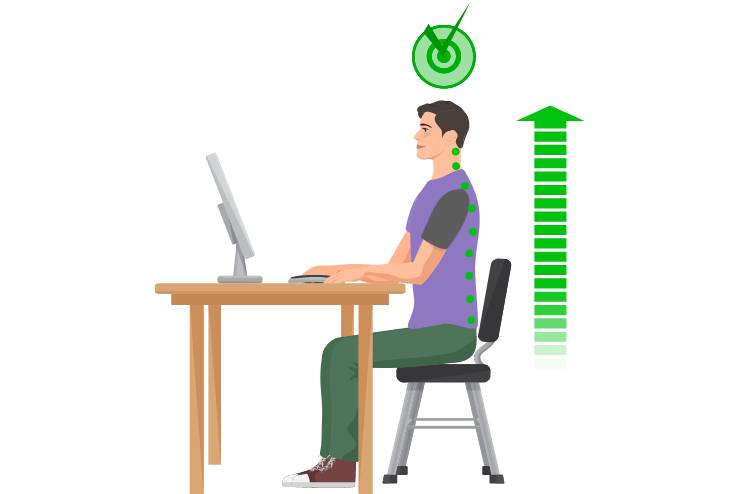Affiliate Disclaimer
Some links in this article are affiliate links. We may earn a small commission if you make a purchase through these links, at no extra cost to you. We only recommend products we find useful to our readersWaking up with a stiff neck is most often blamed on poor sleep posture. While sleep position is the most common culprit for neck pain, there are a whole myriad of other reasons that could cause you to wake up with a stiff neck.
Common Culprits Beyond Sleep

1. Poor Posture:
We spend long hours in front of computer screens or mobile devices these days, which causes a lot of strain on the neck muscles. One major factor contributing to this discomfort is our poor posture, particularly slouching. When the head is positioned forward, it forces the neck to support our head’s weight in an unnatural way. Over time, this unnatural alignment leads to stiffness and discomfort in the neck muscles.
2. Muscle Strain:
Muscle strain can be caused by daily activities, such as lifting heavy objects or sudden jerky movements. Even minor overexertion during physical exercise may lead to microscopic tears in muscle fibers. As a result, we face discomforts, including inflammation of the muscles, which manifests as a stiff neck.
3. Underlying Medical Conditions:
Neck pain can also result from certain pathological conditions. For instance, arthritis, especially of the cervical spine, may result in persistent stiffness of the neck. Fibromyalgia is a syndrome with widespread musculoskeletal pain, which often occurs in the neck and shoulder region, causing continuous pain.
4. Stress and Tension:
Emotional stress causes physical tension, especially in the neck and shoulder areas.
Also, read: 10 Best Back Massagers for Muscle Knots
Identifying the Cause

When experiencing discomfort, it’s essential to consider various potential causes to determine the appropriate response.
Symptoms to Watch For
Certain symptoms can signal that the condition may be more serious:
- Severe neck pain without apparent cause
- A lump in your neck
- Fever
- Headache
- Swollen glands
- Nausea
- Vomiting
- Trouble swallowing or breathing
- Weakness
- Numbness
- Tingling
- Pain that radiates down your arms or legs
- Inability to move your arms or hands
- Inability to touch your chin to your chest
- Bladder or bowel dysfunction
When to Seek Medical Attention
See a doctor immediately if you experience any of the following symptoms:
- Severe neck pain without an apparent cause
- A lump in your neck
- Fever
- Headache
- Swollen glands
- Nausea
- Vomiting
- Trouble swallowing or breathing
- Weakness
- Numbness
- Tingling
- Pain that radiates down your arms or legs
- Inability to move your arms or hands
- Inability to touch your chin to your chest
- Bladder or bowel dysfunction
These signs may indicate a more serious condition that requires prompt medical attention.
Also, read: How To Get Rid Of Neck Pain? 14 Effective Remedies And Exercises
Prevention and Relief

Most neck pain can be prevented or managed if you make simple changes to daily activities. Here are some strategies for improving your posture, doing some gentle exercises, over-the-counter pain relief considerations, and creating a sleep-conducive environment.
Tips for Improving Posture
Good posture, whether you’re sitting at your desk, staring at your phone, or just out running some errands, will help you prevent neck pain. Poor posture places strain and damage on the structures in your neck, which can lead to chronic discomfort. Improve your posture:
- Draw your shoulders away from your ears: This helps reduce tension in the neck and shoulder muscles.
- Gently engage your abdominal muscles: A strong core supports your spine and helps maintain proper alignment.
- Hold your head in line with the center of your body: Avoid letting your head shift forward, which adds extra pressure on your neck muscles.
- Lift your chest upward: Keeping your spine straight helps distribute weight evenly, reducing strain on your neck.
Also, read: 6 Best Yoga Asanas For Neck Pain
Gentle Exercises for Neck Pain

Exercises and stretches can strengthen the muscles in your neck, making them more flexible and helping to relieve tension. Here are some neck stretches you can try:
- Forward and Backward Tilt: Start with your head squarely over your shoulders. Lower your chin to your chest and hold for 15-30 seconds. Then, tilt your chin up toward the ceiling, hold for 10 seconds, and return to the start position. Repeat several times.
- Side Tilt: Stand with your feet hip-width apart. Gently tilt your head toward your right shoulder, trying to touch it with your ear. Hold for 5-10 seconds, then return to the start position. Repeat on the left side. For an extra stretch, lightly press your head with your fingertips.
- Side Rotation: Keep your head squarely over your shoulders. Slowly turn your head to the right until you feel a stretch. Hold for 15-30 seconds, then return to the center. Repeat on the left side.
- Shoulder Roll: Stand up straight. Raise your shoulders and move them in a circular motion forward six times, then backward six times.
- Neck Retraction: While sitting or standing, look straight ahead with your chin slightly tucked. Pull your head and chin backward as if creating a double chin. Hold for 3-5 seconds, then return to the start position. Repeat 10-15 times.
- Towel Pull: Stand with a rolled-up towel behind your neck, holding both ends. Tilt your head back, allowing the towel to support your neck as you move. Return to the start position and repeat 10 times.
- Chin Tucks: Lie down on your back. Pull your chin backward and down as far as possible. Hold for 1-5 seconds, then release. Repeat 10 times.
These exercises can help alleviate neck pain and prevent future discomfort. However, if you already have pain, consult your doctor before starting any new exercise regimen.
Over-the-Counter Pain Relief Options

Sometimes neck pain can be caused by inflammation in the spine’s discs, nerves, or joints. Nonsteroidal anti-inflammatory drugs, such as ibuprofen, naproxen, and aspirin, decrease inflammation and quite often relieve pain. They are available over-the-counter and quite potent against mild and moderate neck pain.
If neck pain becomes disabling and interferes with your daily activities, consult a doctor. In some cases, stronger prescription medications may be recommended for short-term relief until other treatments, such as NSAIDs or muscle relaxants, take effect. However, long-term use of prescription pain relievers is generally discouraged due to the potential for changes in the nervous system that can increase pain sensitivity.
You should see a doctor if your neck pain is disabling and interferes with daily activities. Sometimes, stronger prescription medications may be recommended to provide short-term relief while NSAIDs or muscle relaxants take effect. However, usually, prescription pain relievers are not advised for long-term use, as changes in the nervous system may happen, making a person more sensitive to pain.
- Prescription Pain Relief Options: For more severe or persistent neck pain, a doctor may prescribe medications such as muscle relaxants or corticosteroids:
- Muscle Relaxants: These can be helpful in treating painful muscle spasms associated with conditions like degenerative disc disease or herniated discs. Muscle relaxants work by eliminating spasms and easing pain.
- Corticosteroids: If other medications fail to provide relief, corticosteroids may be prescribed to reduce inflammation, relieve pressure on affected nerves, and lessen pain. These steroids are typically taken for 7 to 10 days, after which a doctor will reassess your symptoms to determine the next steps in treatment.
Creating a Sleep-Conducive Environment

Your sleeping position and environment can significantly impact neck pain. Consider the following tips to create a sleep-conducive environment:
- Choose the right pillow: A pillow that supports the natural curve of your neck can help prevent pain. Avoid using too many pillows, which can misalign the spine.
- Sleep on your back or side: These positions are generally better for maintaining proper spinal alignment. Avoid sleeping on your stomach, which can strain the neck.
- Maintain a comfortable sleep temperature: A cool, quiet, and dark environment can promote restful sleep, allowing your body to heal and recover.
By incorporating these strategies into your daily routine, you can help prevent neck pain and find relief from existing discomfort.
Conclusion
A stiff neck can be due to so many things: bad posture, straining your muscles, stress, and sometimes even underlying medical conditions. If you identify the cause and take proper action, you will considerably lower your chances of developing chronic neck pain.
Make sure to take proactive steps in looking after your neck, such as improving your posture, using gentle exercises, over-the-counter pain relief when needed, and ensuring a sleep environment that supports proper spinal alignment.
References
- https://my.clevelandclinic.org/health/symptoms/21179-neck-pain
- https://www.healthline.com/health/neck-pain
- https://www.aurorahealthcare.org/services/aurora-spine-services/neck-pain/prevention
- https://www.webmd.com/fitness-exercise/fitness-neck-stretches
- https://nyulangone.org/conditions/neck-pain/treatments/medication-for-neck-pain
In this Article


















